Darwin Darwin is called, by the people who live here, the last frontier. A bit romantic, what it really means is that amenities are sometime available but not to be counted on. Also ran into something that I can't recall ever having had happen before, a ½ hour time change! The country is "Joe Six-Pack", nice, cordial, but tied to the TV or to horse racing, or football. They love the barbeque and spend a great deal of time outdoors. The country is on fire much of the time. The locals follow an old aboriginal custom of burning the bush to encourage new growth. Consequently, there is the smell of burning or smoke plumes everywhere. On our first trip we went to the crocodile farm, interesting but just another zoo. Darwin is called, by the people who live here, the last frontier. A bit romantic, what it really means is that amenities are sometime available but not to be counted on. Also ran into something that I can't recall ever having had happen before, a ½ hour time change! The country is "Joe Six-Pack", nice, cordial, but tied to the TV or to horse racing, or football. They love the barbeque and spend a great deal of time outdoors. The country is on fire much of the time. The locals follow an old aboriginal custom of burning the bush to encourage new growth. Consequently, there is the smell of burning or smoke plumes everywhere. On our first trip we went to the crocodile farm, interesting but just another zoo.
 As a part of the get acquainted tour we had of the city we went to see the water front. Lots of boats and water. The new thing we saw was a fleet of junks and I mean "junks" anchored in a bay. These ships were from Indonesia and were caught by the Coast Guard fishing in their waters - 200 to 300 miles away from their shores. The Guard always keeps the boat - apparently burns most of them and either puts the fisherman in jail or flies them home. They are mostly fishing for shark fin. As a part of the get acquainted tour we had of the city we went to see the water front. Lots of boats and water. The new thing we saw was a fleet of junks and I mean "junks" anchored in a bay. These ships were from Indonesia and were caught by the Coast Guard fishing in their waters - 200 to 300 miles away from their shores. The Guard always keeps the boat - apparently burns most of them and either puts the fisherman in jail or flies them home. They are mostly fishing for shark fin.
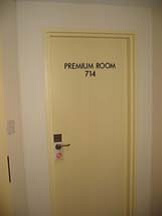 When you are trying to see all of a country in the circular fashion we choose to around the outside), you are bound to begin to see similar things one place to another. The zoo above is a good example. What makes the experiences different is how the place or people introduce the similar environment or culture to you. A simple example is accommodations (another is food). We are staying at "better" hotels throughout the trip. In setting up the tour, the tour company or the country interpreted this to mean "spas". Interestingly, the accommodations have twice so far turned out to be suites, but suits that included the ability to cook in the room and do your own laundry with an in-room washer and dryer. It amuses me to think of a "premier" room in New York or Paris offering similar amenities. When you are trying to see all of a country in the circular fashion we choose to around the outside), you are bound to begin to see similar things one place to another. The zoo above is a good example. What makes the experiences different is how the place or people introduce the similar environment or culture to you. A simple example is accommodations (another is food). We are staying at "better" hotels throughout the trip. In setting up the tour, the tour company or the country interpreted this to mean "spas". Interestingly, the accommodations have twice so far turned out to be suites, but suits that included the ability to cook in the room and do your own laundry with an in-room washer and dryer. It amuses me to think of a "premier" room in New York or Paris offering similar amenities.
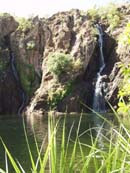 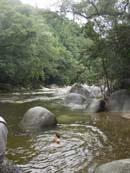 The one of the full days we had in the "Top End" we spent going to a place called Litchfield, much like our National Parks. Tour bus after tour bus leave the hotel area about seven a.m. and head for this destination or ones further on. I pictured being mobbed. The guide was great. He spent the day keeping us pretty well in areas of the park that were not crowded or approaching scenic areas by back routes or at off times. Waterfalls and swimming holes that are available all through the year, even in the dry season. The one of the full days we had in the "Top End" we spent going to a place called Litchfield, much like our National Parks. Tour bus after tour bus leave the hotel area about seven a.m. and head for this destination or ones further on. I pictured being mobbed. The guide was great. He spent the day keeping us pretty well in areas of the park that were not crowded or approaching scenic areas by back routes or at off times. Waterfalls and swimming holes that are available all through the year, even in the dry season.
The country, outside of the largest cities, is really quite undeveloped (even 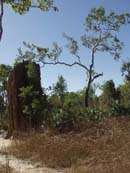 though the natives think that there is no "wild" country left). Animals, birds, flowers, plants and insects of all varieties are to be found everywhere. As I mentioned, on Hamilton Island, cockatoos are a pest. In Litchfield, the Black Kite, a bird of prey, is so plentiful and so unafraid of people that picnickers have been known to have food snatched out of their hand by swooping Kites! What is most amazing are the number of termites, and the number of kinds of termites, that are everywhere. The Aussies build houses on stilts out of treated lumber with pie-plates atop the though the natives think that there is no "wild" country left). Animals, birds, flowers, plants and insects of all varieties are to be found everywhere. As I mentioned, on Hamilton Island, cockatoos are a pest. In Litchfield, the Black Kite, a bird of prey, is so plentiful and so unafraid of people that picnickers have been known to have food snatched out of their hand by swooping Kites! What is most amazing are the number of termites, and the number of kinds of termites, that are everywhere. The Aussies build houses on stilts out of treated lumber with pie-plates atop the  posts to keep these and other creatures out of the house. There are termite mounds everywhere, on trees (which they hollow out), in huge cathedral mounds (the one in the picture is about 20 feet high), and in flood plains. The second picture that looks like a graveyard of tombstones shows the magnetic termites that all build their mounds wide and flat, with a north-south orientation to the mound. posts to keep these and other creatures out of the house. There are termite mounds everywhere, on trees (which they hollow out), in huge cathedral mounds (the one in the picture is about 20 feet high), and in flood plains. The second picture that looks like a graveyard of tombstones shows the magnetic termites that all build their mounds wide and flat, with a north-south orientation to the mound.
Perth Perth is a medium sized city that is based on metals (iron and gold) and is a major shipping port for the surrounding agricultural area. It is built around a major river, the Swan, and its suburbs are sprawled for miles all along its banks. The houses and condos that faced the river are typically modern or palatial. The downtown has few remaining buildings from its early times and skyscrapers are everywhere. Like many downtowns, the shops close at 6 PM and the city is empty. Perth is a medium sized city that is based on metals (iron and gold) and is a major shipping port for the surrounding agricultural area. It is built around a major river, the Swan, and its suburbs are sprawled for miles all along its banks. The houses and condos that faced the river are typically modern or palatial. The downtown has few remaining buildings from its early times and skyscrapers are everywhere. Like many downtowns, the shops close at 6 PM and the city is empty.
 We went on a tour of the city and surrounding suburbs, starting with a river cruise and ended up in a town called Fremantle. This was the home of the America's cup in the 80's and the town was rediscovered at that time. It is a quaint walking area, full of old buildings, open markets, and restaurants. We then cabbed back to the city. We walked the downtown and back to the hotel. Our day today started at 4:30 AM. We went on a tour of the city and surrounding suburbs, starting with a river cruise and ended up in a town called Fremantle. This was the home of the America's cup in the 80's and the town was rediscovered at that time. It is a quaint walking area, full of old buildings, open markets, and restaurants. We then cabbed back to the city. We walked the downtown and back to the hotel. Our day today started at 4:30 AM.
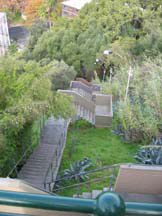 After a talk with the tour guide, we cancelled our trip. The itinerary would have had us fly 2 1/2 hours to a place to look at dolphins, After a talk with the tour guide, we cancelled our trip. The itinerary would have had us fly 2 1/2 hours to a place to look at dolphins, 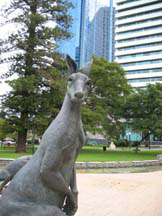 get back in a plane again and fly to a beach that had a lots of shells (that you could not touch) and then fly back 2 1/2 hours. The last part of the flight would likely have been through rough weather (it is getting stormy looking now - an hour after the proposed take-off). We went back to bed, got up and walked around Perth. Carol had been here before and was anxious to see the city. We walked for five or six hours and covered almost all there was to see. The city is pretty hilly - see the stairs and so we walked up and down a lot. I am stiff now and am interested to see what tomorrow will bring. Interestingly, the get back in a plane again and fly to a beach that had a lots of shells (that you could not touch) and then fly back 2 1/2 hours. The last part of the flight would likely have been through rough weather (it is getting stormy looking now - an hour after the proposed take-off). We went back to bed, got up and walked around Perth. Carol had been here before and was anxious to see the city. We walked for five or six hours and covered almost all there was to see. The city is pretty hilly - see the stairs and so we walked up and down a lot. I am stiff now and am interested to see what tomorrow will bring. Interestingly, the 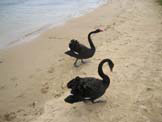 tour guide that we had yesterday (and the one that set up today) was the poorest we have had. One of the stories she told us (after I said that I thought that I had seen a black swan on our boat-ride yesterday) was that the river was named the Swan after the black swan but that there were no longer black swans to be seen on the river. Today, on our walk we saw five and were all but mobbed by three of them. Either they all have returned from wherever they were just recently or our guide didn't know what she was talking about. tour guide that we had yesterday (and the one that set up today) was the poorest we have had. One of the stories she told us (after I said that I thought that I had seen a black swan on our boat-ride yesterday) was that the river was named the Swan after the black swan but that there were no longer black swans to be seen on the river. Today, on our walk we saw five and were all but mobbed by three of them. Either they all have returned from wherever they were just recently or our guide didn't know what she was talking about.
AdelaideWe are on the way to Adelaide. This morning we read the morning paper at breakfast. Journalism in these cities is something. The main paper, the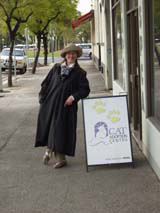 Australian, only has one edition on the weekend. The other papers have been supermarket variety, with no real news and plenty of gossip and opinion. Since I am writing this in the plane, I am reminded of two other differences that are interesting; meals are served with real knives and the security check-in is set sop tight that it not only catches the steel knee, it also catches the screw I have in the other leg. Go figure. Australian, only has one edition on the weekend. The other papers have been supermarket variety, with no real news and plenty of gossip and opinion. Since I am writing this in the plane, I am reminded of two other differences that are interesting; meals are served with real knives and the security check-in is set sop tight that it not only catches the steel knee, it also catches the screw I have in the other leg. Go figure.
The city is an urban planner's dream. It is one mile square - exactly, with the town being one-half mile from the center in every direction one can walk. 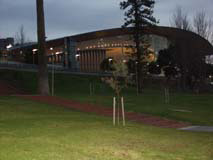 It is laid out as a grid with traffic lights at every major intersection. The city is surrounded by a green space and has a river running through it. Inside the green space are churches (it is called the city of churches), sports stadiums, an opera house, convention center (picture above), live theater playhouse, a golf course, professional tennis courts, three It is laid out as a grid with traffic lights at every major intersection. The city is surrounded by a green space and has a river running through it. Inside the green space are churches (it is called the city of churches), sports stadiums, an opera house, convention center (picture above), live theater playhouse, a golf course, professional tennis courts, three 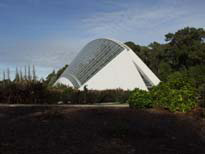 rowing clubs, a botanical garden, a zoo, a gambling casino, a botanical garden, with a greenhouse that houses a tropical rain forest (see picture) in fact, all the things one might think of that they might want in a city. (Including a cat rescue center supported by Wiskas - see picture above). Its transportation is by car, by bus, including a free bus that serves the urban area, and electric tram to the beach. A special bus line runs the bus like a train over a special track at 80 MPH and then converts it to a regular bus in the city center. rowing clubs, a botanical garden, a zoo, a gambling casino, a botanical garden, with a greenhouse that houses a tropical rain forest (see picture) in fact, all the things one might think of that they might want in a city. (Including a cat rescue center supported by Wiskas - see picture above). Its transportation is by car, by bus, including a free bus that serves the urban area, and electric tram to the beach. A special bus line runs the bus like a train over a special track at 80 MPH and then converts it to a regular bus in the city center.
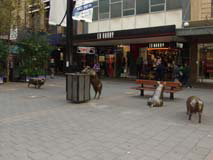 The architecture is mixed modern (restricted to 25 stories and only one that tall) and preserved historical. The driver from the airport claimed that one could be anywhere in Adelaide in 45 minutes. It had desert, mountains, agricultural areas, and wineries within an hours drive. The airport is 20 minutes away and the train station right in the center. It is beautiful, scenic, clean, and safe. Shopping main streets and malls. It is, in addition to agriculture, the Detroit of Australia, the whole town being supported primarily by automotive-related industries. The architecture is mixed modern (restricted to 25 stories and only one that tall) and preserved historical. The driver from the airport claimed that one could be anywhere in Adelaide in 45 minutes. It had desert, mountains, agricultural areas, and wineries within an hours drive. The airport is 20 minutes away and the train station right in the center. It is beautiful, scenic, clean, and safe. Shopping main streets and malls. It is, in addition to agriculture, the Detroit of Australia, the whole town being supported primarily by automotive-related industries.
The surrounding countryside is equally magical. There are 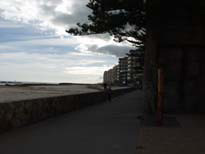 hillsides that are a duplicate of those in Berkeley, California (complete with a disastrous forest fire and eucalyptus trees) - still 25 minutes from the center. If you do not want to hang from the hillsides, the towns on the other side are as quaint as any in the world. If this is not enough, there are vineyards and wine tours. Twenty minutes in another direction brings you to the sea shore with all of the ambiance of beach towns . A truly amazing area. hillsides that are a duplicate of those in Berkeley, California (complete with a disastrous forest fire and eucalyptus trees) - still 25 minutes from the center. If you do not want to hang from the hillsides, the towns on the other side are as quaint as any in the world. If this is not enough, there are vineyards and wine tours. Twenty minutes in another direction brings you to the sea shore with all of the ambiance of beach towns . A truly amazing area.
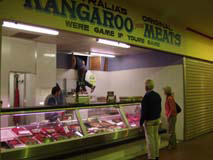 The day's trip started in the city market. I am always interested in markets throughout the world and have visited many. Never have I seen anything like this one - more precisely, not anything like this one all in one place. There were stalls specializing in every conceivable food, country; for example, thee was one that sold everything that had to do with tea, another with coffee, another with aboriginal foods, another with health foods. Added to this are the normal stalls that sell meat, including ones that sell only special kinds of meat such as sausages or kangaroo. Others that sold fish, or The day's trip started in the city market. I am always interested in markets throughout the world and have visited many. Never have I seen anything like this one - more precisely, not anything like this one all in one place. There were stalls specializing in every conceivable food, country; for example, thee was one that sold everything that had to do with tea, another with coffee, another with aboriginal foods, another with health foods. Added to this are the normal stalls that sell meat, including ones that sell only special kinds of meat such as sausages or kangaroo. Others that sold fish, or 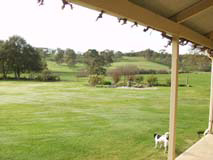 specialized in nuts or spices. There was a whole oriental section that had shops catering to the ingredients used traditionally in each of these varied countries. Amazing. specialized in nuts or spices. There was a whole oriental section that had shops catering to the ingredients used traditionally in each of these varied countries. Amazing.
We then went through the countryside to the wine country. I have visited wineries before and was prepared to be under whelmed. But again I was fooled. 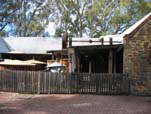 The first "tour" was a visit to a retired vintner's home. A visit and then a stroll through their gardens, culminating with a tasting in their "cellar door". The first "tour" was a visit to a retired vintner's home. A visit and then a stroll through their gardens, culminating with a tasting in their "cellar door".
The next stop was at a boutique winery that only sold by mail. Every grape is picked by hand (as opposed to by machine) and the layout was pretty primitive. The wine was fairly light, in fact, it would be dangerous for me to drink as I 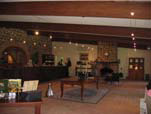 would think it was water or fruit juice (until the next morning). would think it was water or fruit juice (until the next morning).
Finally, we went to a winery and were treated to a lecture on the wines , some snacks, and a tasting of six of their wines. It was interesting and again I was surprised that I like one of the red wines. It was a sales pitch though for the wine that was being shipped to the US. The day ended with a later lunch at a quaint restaurant and a ride through the countryside. Melbourne in the |
Port Douglas | Darwin - Perth - Adelaide | Melbourne | New Zealand | Tasmania - Blue Mountains
Retrospection